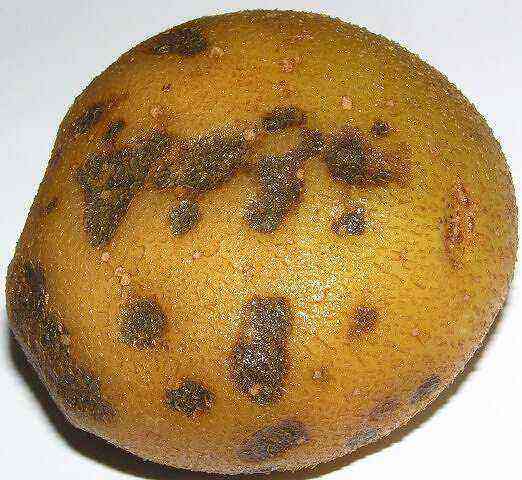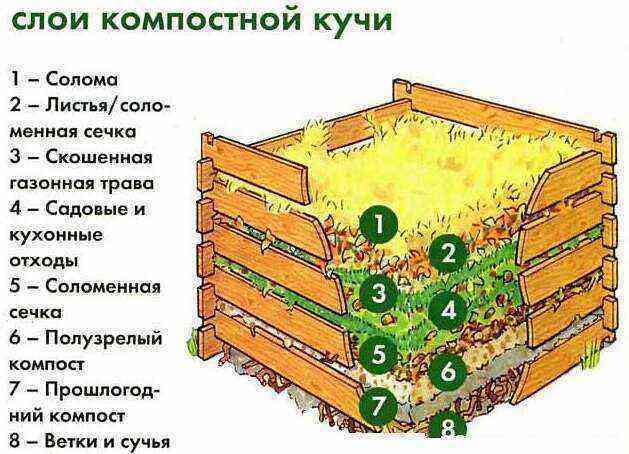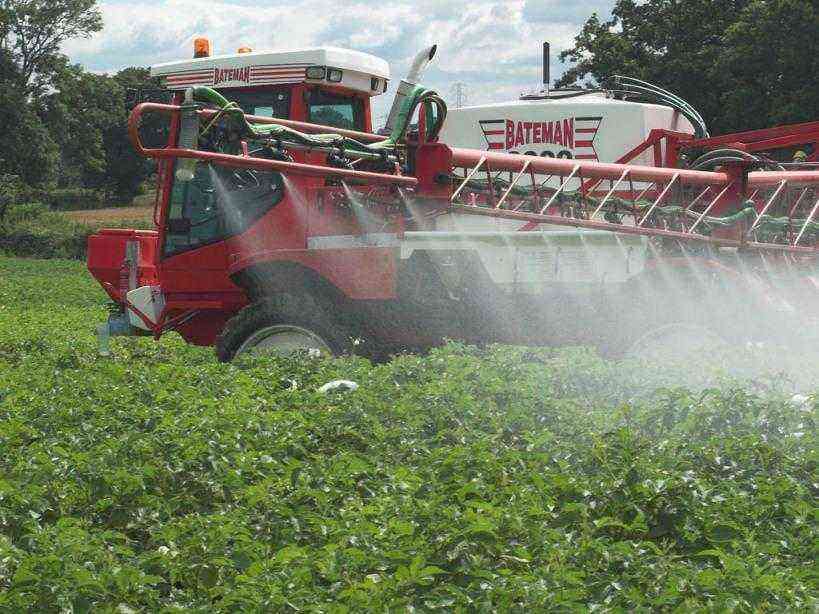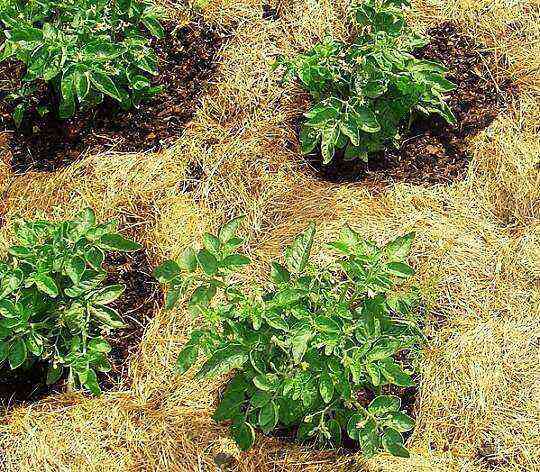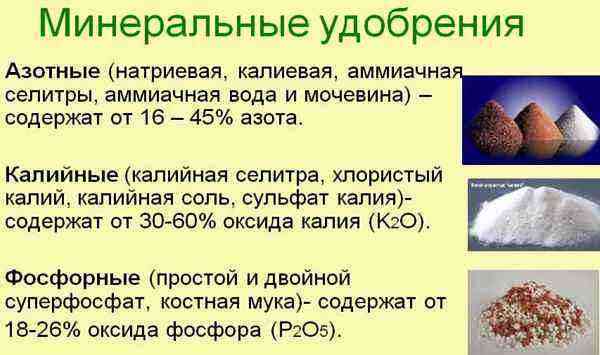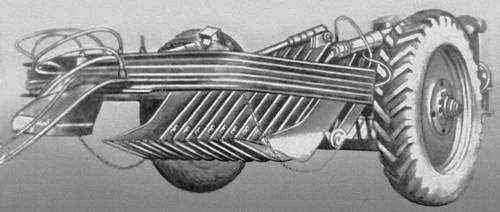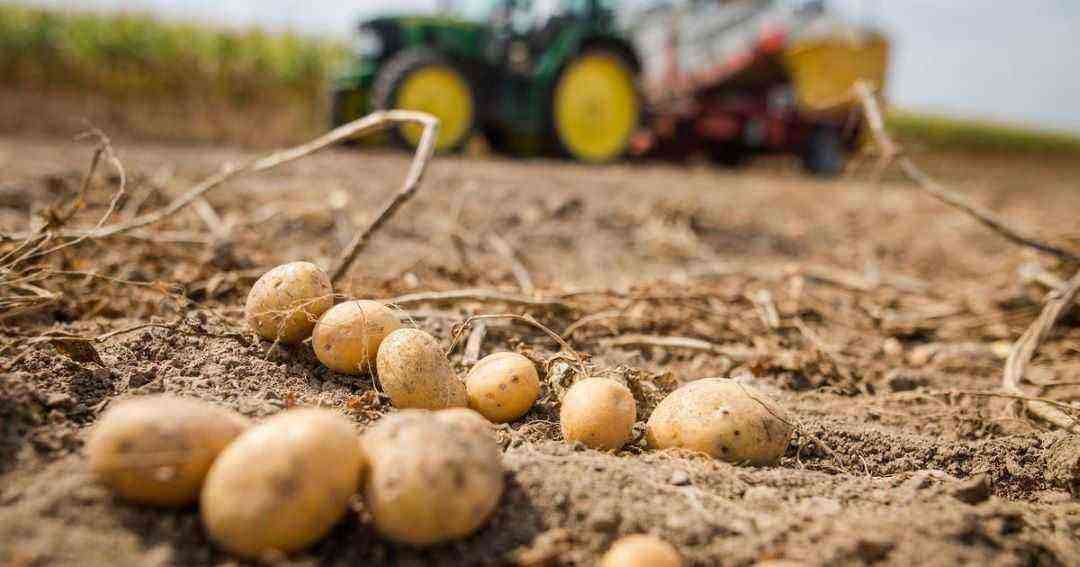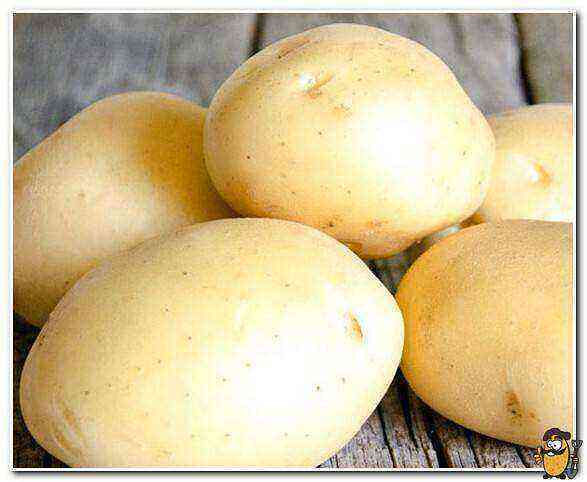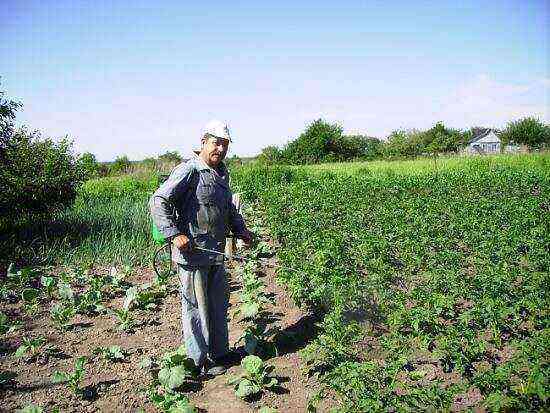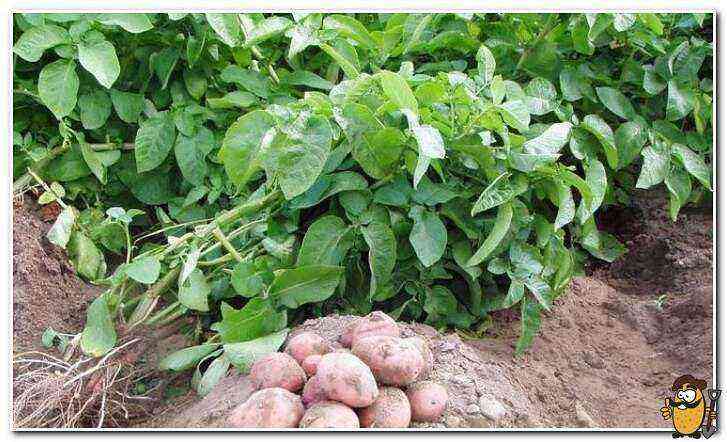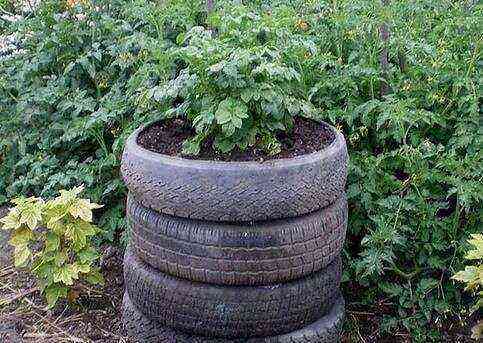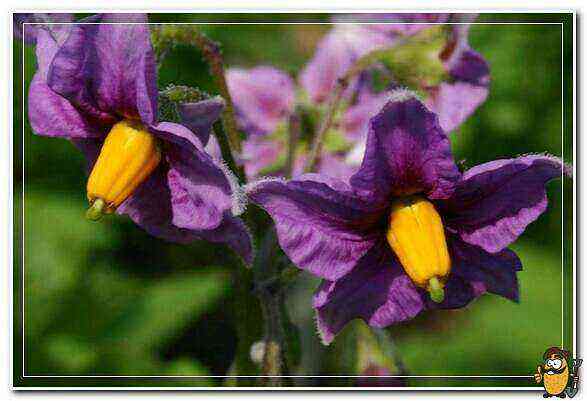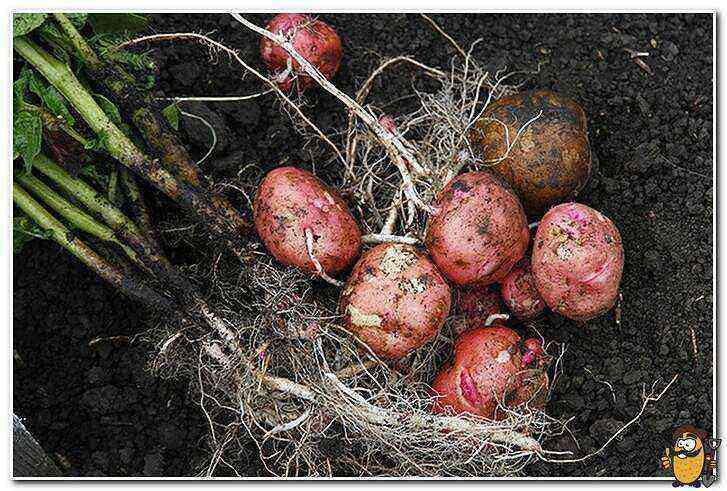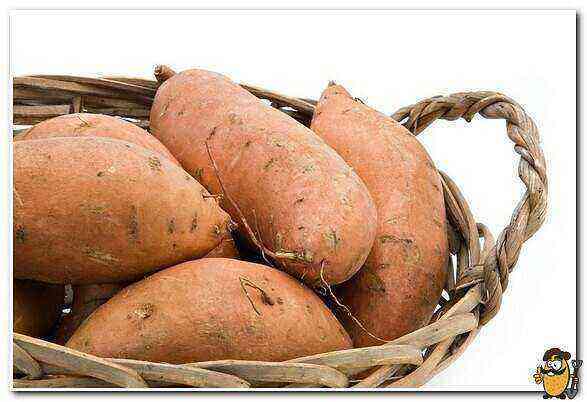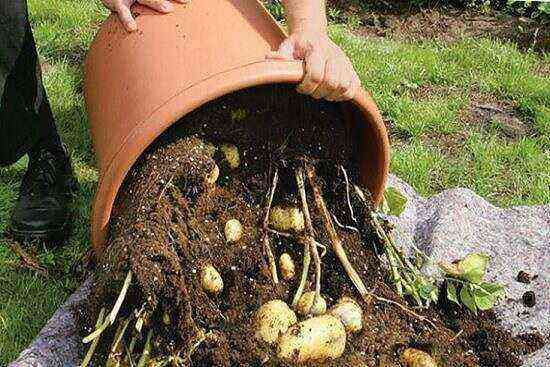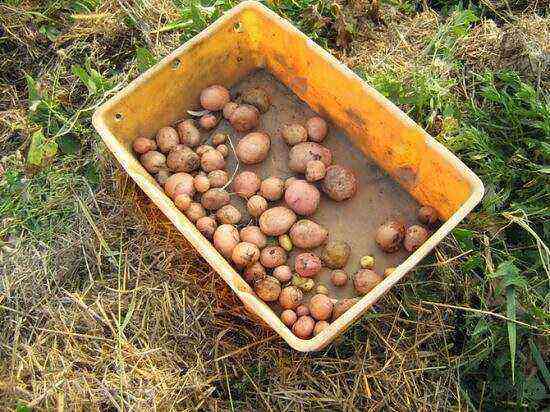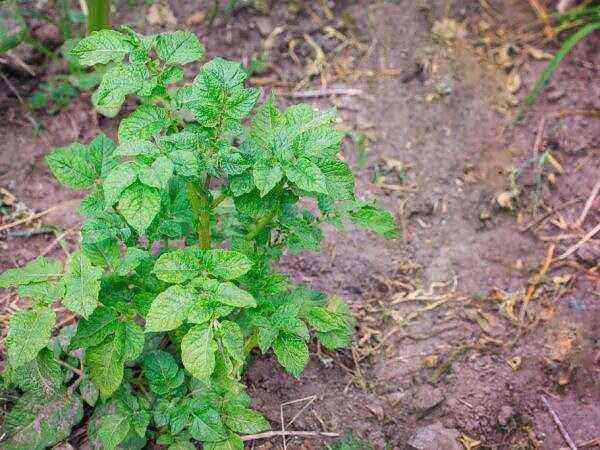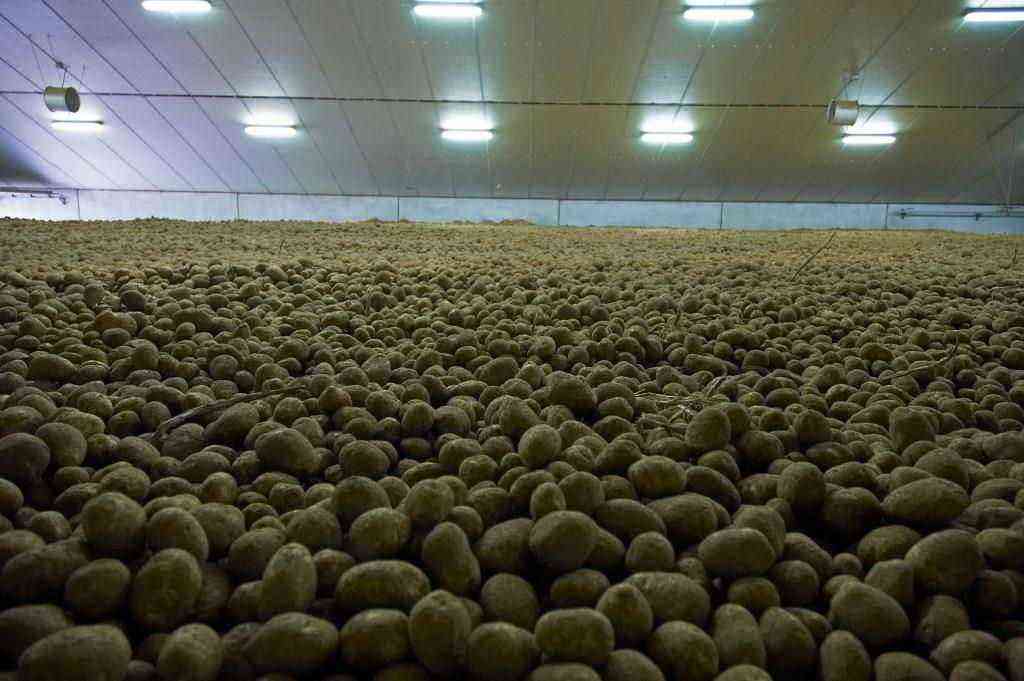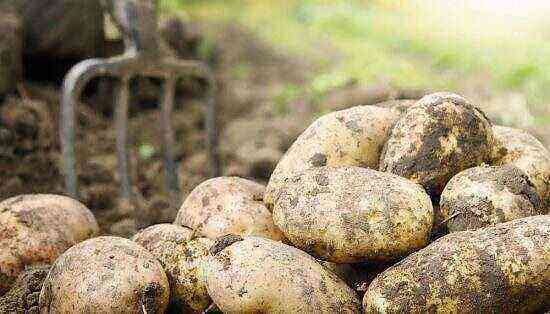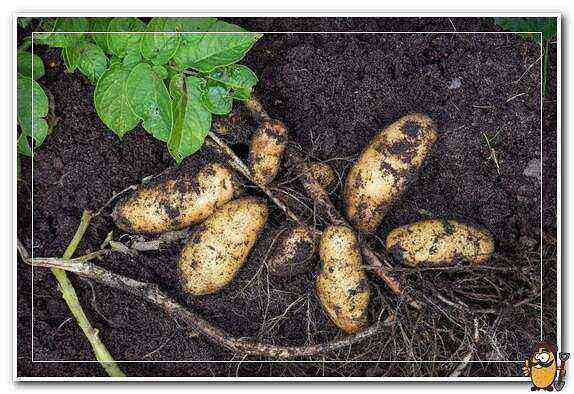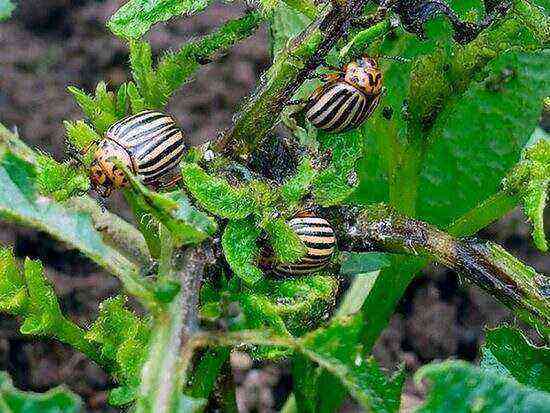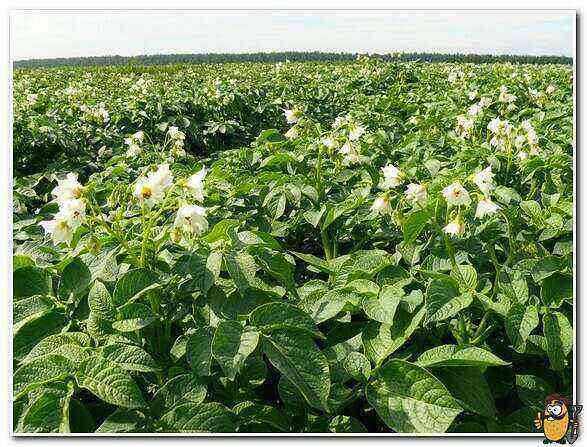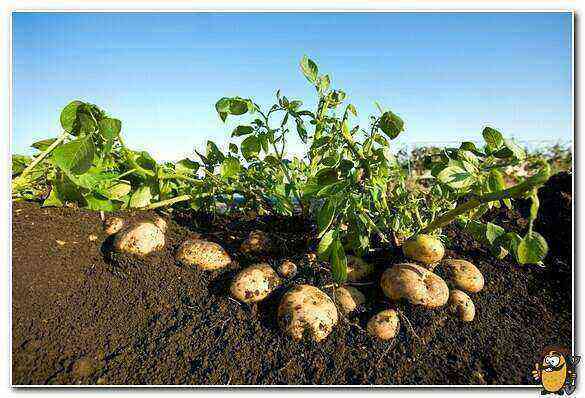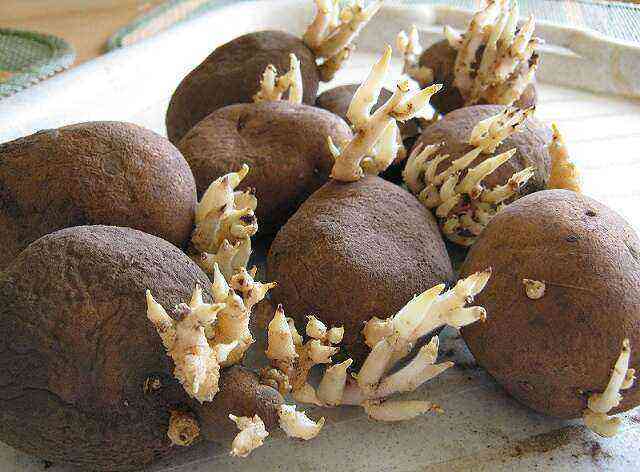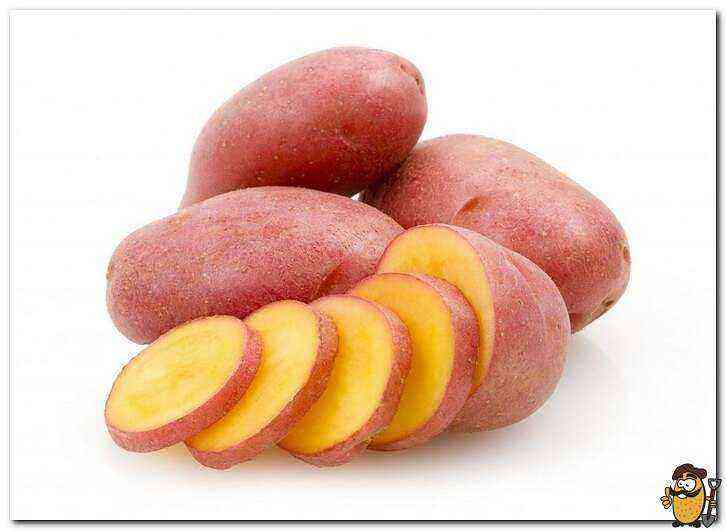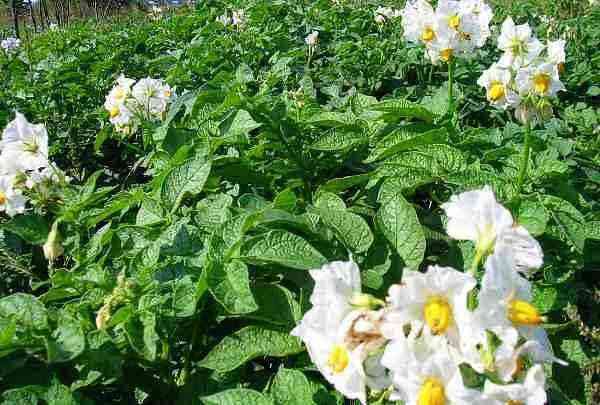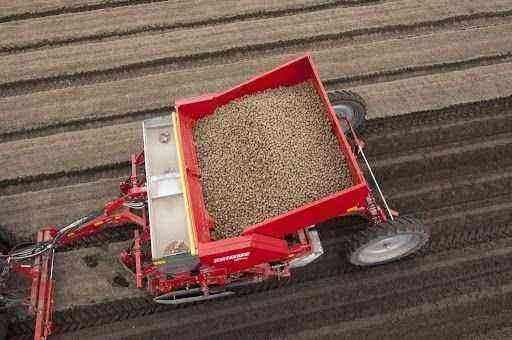Correct planting depth of potatoes
At what depth to plant
Potatoes are fed with slurry or diluted bird droppings; if necessary, apply mineral fertilizers, preferably in the form of a solution. But the amount and composition of fertilizing very much depends on the composition and quality of the soil, as well as on how well it was fertilized before planting. Do not overuse feeding, because it can deteriorate the quality of the tubers.
Harvesting of potatoes begins after the tops are completely dead. In the middle lane, early varieties are dug up, starting from the end of July, the rest from the second decade of September to the first decade of October. Two weeks before harvesting, the tops are mowed, which contributes to the compaction of the peel and better ripening of the tubers. Digging is done with a shovel, pitchfork or industrial diggers. In this case, it is necessary to avoid damage to the tubers, since during storage, potatoes with damage are more affected by diseases.
Cold damage to tubers occurs at -2 ° C. Storing potatoes at low positive temperatures and at 0 ° C promotes the accumulation of sugars in the tubers. This is a reversible process, and at a temperature of + 10 ° C, the normal taste of the potatoes returns.Weeds
Experienced gardeners noticed that joint planting of early and late varieties of potatoes has a beneficial effect on each other (early varieties “drive up” the ripening of later ones).
With excessive doses of nitrogen and calcium, scab appears on the potatoes. It is better to add nitrogen simultaneously with potassium, and limit the use of ash.
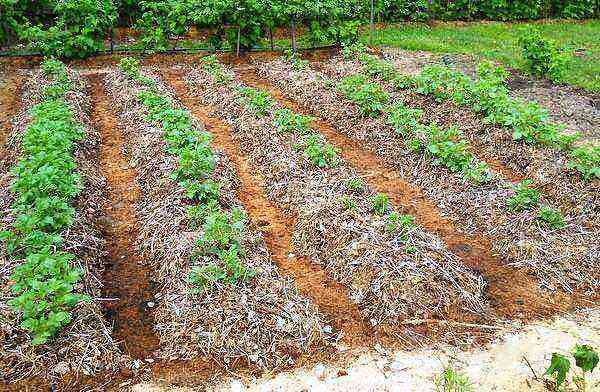
Fertilizers. Manure can be applied directly under the crop, which can increase the potato yield by 2 times, but at the same time, the risk of potato scab disease will increase. Manure under potatoes can be applied in two ways: by scattering it over the entire plot or by embedding it in grooves or holes (on the same day). You can use peat-manure composts (3: 1). On average, 1-5 kg of organic matter is applied per 10 m².
5,0-5,5. Although potatoes tolerate acidic soil, the yield is higher after
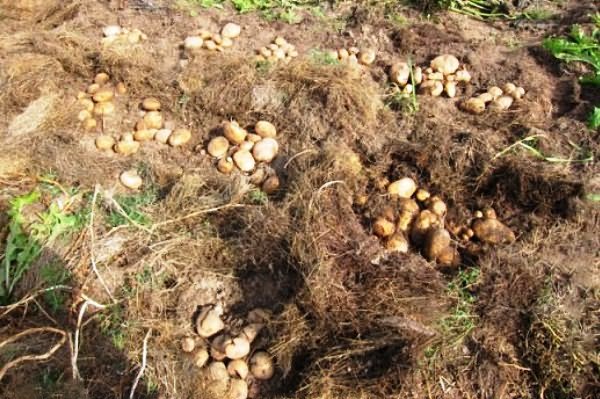
The relationship between depth and landing time
Square-nested method of planting potatoes. To do this, divide the garden into several squares and make a hole in each of them. The nests should be approximately half a meter apart.
In areas in the extreme south, the landing is carried out at the end of March, the beginning of April is also permissible. Northern areas require landing in May. Then comes the second half of May. A number of requirements are met:
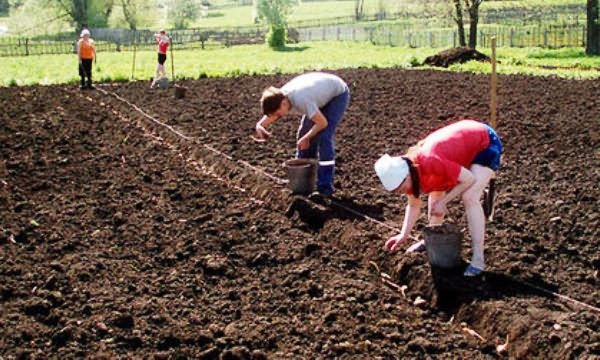
The yield of any vegetable crop depends on many factors: temperature regime, seed quality, timeliness and efficiency of processing, adherence to the rules of planting or sowing. This also applies to growing potatoes. First you need to choose the right variety, germinate the seeds and prepare for planting in the soil. If you are a novice gardener, you should learn some rules, since even the depth of planting potatoes plays an important role in the harvest.
When growing potatoes, you have to deal with its pests, of which the most vicious are the Colorado potato beetle and wireworm. Folk remedies for fighting the Colorado potato beetle: onion peel (sprinkle plantings, add to the holes); dusting the plantings with sifted wood ash; planting calendula with potatoes, beans – with potatoes or along the perimeter of the field, beans – along the perimeter of the potato. From the wireworm, according to the observation of many gardeners, sowing of leafy mustard and peas as green manure crops to planting potatoes helps.

Potatoes are stored at a temperature of 2 to 4 ° C and a humidity of 90-92%. They use cellars, storage facilities, and in their absence, they arrange special pits or heaps. Before laying for the winter, the tubers should be dried, cleaned of soil residues, sorted from sick and injured specimens, which will significantly reduce storage losses.When potato tops are affected by late blight, macrosporiosis and other diseases, the tops are pre-mowed and destroyed, and the tubers are left in the ground for 2-3 weeks to form a strong peel.
Hilling. When hilling potatoes, it is important not to damage the roots. The first hilling is carried out at a seedling height of 20 cm, while sprinkling with earth the entire lower part of the stem to the leaves. The second hilling is carried out when the soil is waterlogged to provide air access to the tubers.
Video “Preparing the soil and planting potatoes”
For the best illumination of potato bushes with the sun, the rows are oriented from north to south.
What is the depth of planting potatoes
Potash and phosphate fertilizers increase the resistance of potatoes to diseases. In places of distribution
How to plant potatoes
Instead of manure, you can use
- Before planting root crops, fertilize the ground with high quality, for which a bucket of humus is introduced into each of the dug nests
- Planting depth for the northern and central regions on light soils is 10-12 cm, on heavy soils, 8-10 cm, peaty soils require 6-7 cm.The southern edges for planting require 14-16 cm. The tops should be planted at 2-3 cm, and this indicator is smaller than for whole tubers;
- The planting depth of potatoes is classified into shallow, medium, deep. With shallow planting, seeds are buried to a depth of 5-6 cm. Usually this method is used on loamy soils. Loamy sands and peats allow deeper planting – up to 10 cm. Potatoes are also planted to a depth of more than 10 cm, this type is accordingly called deep. It is important that the planting depth is the same throughout the entire area. To achieve this goal, they use specialized equipment.
- Potato varieties are divided into early, medium and late. It is important to consider a few rules:
In March, gardeners in the middle strip retrieve seed potatoes from storage for germination. It takes 35 to 40 days to prepare the planting material well.
Potato planting methods – what should a gardener choose?
Planting potatoes – general rules for everyone
In the middle lane, potatoes ripen in about 4 months. Modern varieties provide the maximum yield from 400 to 800 c / ha. Successful cultivation requires quality seeds and proper care.With the threat of frost, potato shoots are covered with soil, with a layer of 2-3 cm, which will help them withstand even -5 ° C, if the shoots are already quite large, they are first bent down and sprinkled with earth (you do not need to dig out small shoots later). Sprinkling will protect from light frosts.Some put a grain of bean in each hole with a tuber to repel underground pests. The disadvantages of such plantings are as follows: the beans develop before the potatoes, therefore they take potassium from the tuber, shade the young tops. The root system of the beans enriches the soil with nitrogen, its surplus can provoke the growth of potato tops to the detriment of the formation of tubers. It is enough to plant the beans around the perimeter of the potato field.
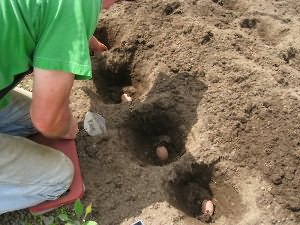
Late blight
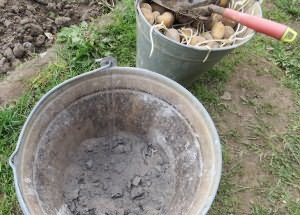
… During the season, you need to carry out about three hilling. Water the garden bed only with water that has been preheated in the sun.
Potato planting methods – what to choose?
Density when planting on well-fertilized, possibly fertile soils is permissible thicker. For poorly fertilized, poor soils – less often. Early varieties must be planted densely. Larger tubers require more space. And small and tops need frequent planting;
- Planting depth depends not only on the type of soil, but also on the size of the seed. If the tubers are small, then they can be embedded shallowly. For a seed weighing 50-80 g, the best embedding depth is 8-9 cm, or when planting in ridges – 10-12 cm.For finer material with a flat surface, embedding is carried out to a depth of 6-7 cm, and in ridges – 8-9 see
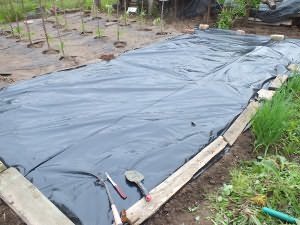
- 1. Choose only zoned varieties.
- It is better to select tubers for planting in the fall, when harvesting. Planting potatoes are taken from the best bushes, choosing healthy tubers about the size of a hen’s egg. Probably the most common mistake: small potatoes are laid for planting, which are not eaten. Thus, they personally worsen the harvest, contribute to the degeneration of varieties, because actually the worst specimens are selected – insufficiently fertile, insufficiently developed.
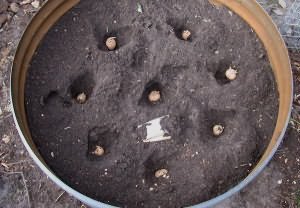
- It is better to select tubers for planting in the fall, when harvesting. Planting potatoes are taken from the best bushes, choosing healthy tubers about the size of a hen’s egg. Probably the most common mistake: small potatoes are laid for planting, which are not eaten. Thus, they personally worsen the harvest, contribute to the degeneration of varieties, because actually the worst specimens are selected – insufficiently fertile, insufficiently developed.
- Potato tubers germinate when the soil at the depth of their occurrence warms up to 7-8 ° C, at the same time the development of the above-ground part begins. The tops do not tolerate frost, they die already at -1 – 3 ° C.Flowers (or better buds) of potatoes must be cut off so that the plant does not waste energy on the formation of seeds.Planting depth of tubers
, Rhizoctonia, bacterial diseases, scab, the doses of potassium (2 times) and phosphorus (1,5 times) should be increased.
Accessories for manual planting of potatoes
(Green fertilizers), which will enrich the garden with organic matter, is tantamount to applying 200 kg of manure per hundred square meters.
Watering potatoes
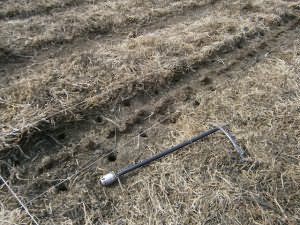
As you can see, there are different ways of planting potatoes – choose the right one, focusing on your strength and the time you can spend on planting. So that planting and caring for potatoes becomes a pleasant job for you, and not a boring necessity.
- An area of 100 square meters when planting whole tubers contains 450-500 bushes. The tops can be planted in the amount of 600-650 bushes. And seedlings or sprouts can be planted according to the density of 700-750 bushes;
- As you know, the Dutch are famous for their unique methods of growing vegetables and various crops.
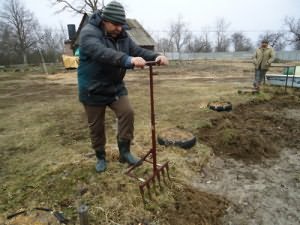
- As you know, the Dutch are famous for their unique methods of growing vegetables and various crops.
- No matter how good and productive the variety is, it will not fully manifest itself in unsuitable soil and climatic conditions.
It is good to turn green the planting tubers in the fall, that is, leave them in the light for a while so that they turn green. Such potatoes are stored more reliably, and for some reason rodents do not touch it.
Planting potatoes. Tips from Andrey Tumanov (ForumHouseTV)
The optimum temperature for growth, flowering and tuberization is considered to be 16-22 ° C. At 20 ° С at night, 29 ° С during the day, the growth of tubers stops, therefore, from the second half of July to the end of August, the harvest does not increase. The time of planting potatoes should be chosen so that by this time the tubers are already practically formed. In the middle lane, this is the second decade of April, in the northern regions – the first decade of May, in the southern regions – early April. By the time of planting at a depth of 10 cm, the soil temperature should be at least 5 ° C.
Potato varietiesThe yield depends on the depth of planting of potatoes. Tubers are placed at a depth of 2-3 cm, which ensures their better heating and germination. The emerging seedlings are completely covered with earth. A week later, the same operation is repeated. As a result, stolons are formed on the covered part of the stem, which increases the yield of potatoes. (planting depth – the distance from the top of the tuber to the soil surface) If the planting dates were missed, the tubers are deepened by another 2-3 cm (especially during dry periods).Good predecessors
From mineral fertilizers for potatoes, ammonium nitrate (before planting 1 kg per hundred square meters) or urea (1 kg per hundred square meters before planting), double superphosphate (1 kg per hundred square meters in spring or autumn), potassium sulfate (2 kg per hundred square meters in spring or autumn) ),
An excess of moisture immediately after planting a tuber prevents the formation of a deep root system.
In order to plant potatoes faster, you can use the tools and devices at hand for planting.
A certain distance must be maintained between the rows, 50-60 cm. The rows between individual bushes for whole tubers are 30-35 cm, tops – 25 cm, shoots – 20 cm;In Holland, potatoes are planted so that the top of the tuber is at ground level, over which a ridge is formed. If you plant even smaller, potatoes from the new crop can be greened.2. Always select and plant multiple varieties.
In the spring, if sprouts begin to appear before their time, they need to be broken off. If it’s a pity to throw it away, try to get seedlings. Strong, dense shoots are carefully broken out of the eyes and buried about 2/3 into the ground in seedling boxes. Watered; can be covered with a film until they take root, but not necessary. Such sprouts can be taken from one healthy potato twice; for the third time, the sprouted tuber must be planted in the ground.
Suitable for growing crops are light and medium-structured soils, chernozem, loamy, sandy, with a slightly alkaline or neutral reaction. Heavy loams are not suitable, because due to the strong compaction of the soil and lack of air, the tubers develop poorly, with excess moisture they are severely affected by rot.
Potato varieties are divided into early (ripening period after planting 50-60 days): Belorussky early, Vesna, Vorotynsky early, Vyatka, Priekulsky early, Prigozhiy 2, Uralsky early, Falensky, Rosalind, Dolphin,Some gardeners recommend placing the potatoes in the holes, with the tubers sprouting down, which will provide a more sprawling (and therefore well-lit and ventilated) bush.Good precursors to potatoes can be
The maximum amount of water is consumed during the budding and flowering period of potatoes and before the tops die off (watering rate is 10 liters per 2 bushes). After abundant watering, the soil is loosened and
Their use will facilitate labor and reduce the time spent on sowing, loosening the soil, and weeding.
100 square meters allow 20-25 kg. tubers with an average size, large – 30-35 kg, the tops will fit in an amount of 10-15 kg.
Formed plants are best placed in the ground when planted deeply. In this case, there is no need to huddle the bushes. But on the other hand, it will be difficult to harvest. Therefore, this type is recommended for use on sandy loam soil, in arid areas.
Firstly, it will help to extend the fruiting time – if you plant varieties with different ripening periods. Secondly, this way you can hedge against any weather or other difficulties: different varieties withstand adverse conditions in different ways, and you will always be with the harvest. If only one cultivar grows, unexpected drought, or rains, or disease can kill everything.
Potatoes are germinated in boxes, perforated plastic bags (perforated for normal ventilation), in bulk on the floor – as conditions permit. It is important that the tubers receive enough light (in the dark, the sprouts will stretch out and weaken) and are kept at temperatures between + 12 ° C and + 15 ° C. At higher temperatures, germination will accelerate and the tubers will wither and weaken.
The site for planting is sunny, open, with a deep arable layer, high humus content. For the prevention of diseases, crop rotation is observed, the potatoes are returned to their original place after 3-4 years. The best predecessors are legumes and winter crops, they enrich the soil with nutrients and cleanse the soil from pests and pathogens of potato diseases. In personal plots, the crop can be grown after any vegetables except nightshade.
Medium early potato varieties (ripening period after planting 60-80 days): Arina, Detskoselsky, Domodedovsky, Zorka, Iskra, Kolpashevsky, Nevsky, Prizer, Sudarynya, Dina.ProblemsSiderates
YMulchThere are several of the most well-known tools that will help in planting root crops:
Here are some guidelines. The southern regions are associated with aridity. Consider this when planting tubers. Therefore, the potato planting depth should be such that water flows normally.There is also an interesting technique in which the seed is laid out on top of slightly loosened soil and covered with 10-12 cm of mulch. Mulch is peat, compost, a mixture of humus with straw or rotted sawdust with sand, to which mineral fertilizers rich in trace elements necessary for potato growth are added. It is recommended to use this method in heavy soil, for example, clayey. To prevent gardening of tubers, you need to add more mulch when the plants reach a height of 20-25 cm.3. Plant, harvest and store different varieties separately.Can be germinated in sawdust or peat. To do this, the tubers are laid in layers in boxes, baskets and similar containers and sprinkled with soil, evenly moistening. It will take about three weeks for sprouts and root buds to appear on the potatoes.
The soil for planting is prepared in the fall, it is plowed on a shovel bayonet, with mechanical processing to a depth of 25 to 27 cm, weeds are removed, fertilizers, organic and mineral, are applied. Nitrogen fertilizers are best used in the spring.Mid-season potato varieties (ripening period after planting 80-100 days): Gatchinsky, Kameraz, Ogonyok, Stolovy 19, Yantarny, Dzhelly, Dubrava, Zhivitsa.Diseases and pests of potatoes
(5 kg per hundred square meters). Of the complex mineral fertilizers for potatoes, nitrophoska (5 kg per hundred square meters) or nitroammofoska (3 kg per hundred square meters) are applied for spring digging. Light sandy soils need magnesium, which is added in the form of magic sulfate (at the rate of 80 g) or dolomite flour – 20 g per 1 m²..Markers that will be needed in order to keep the same distance between the rows of plants. Best used for square nailing or simple trenching.
Before figuring out what is the best way to plant potatoes, you need to read the general rules and guidelines.
The main advantage of this method is the free development of the root system. Mulch perfectly retains moisture and air, contains nutrients. In hot weather, the plants will be cool under the mulch; when the air temperature drops, on the contrary, it will be warm. This will ensure drainage around the roots and suppress weed growth. Loosening of the soil will be provided by earthworms, which, by cultivating the soil, will process organic elements into humus. To combat the Colorado potato beetle, wireworm or other parasites and diseases, green needles are added to the mulch. Thus, using this method, you can get 50% more yield.
You have probably noticed that plants develop differently on the same ridge. This is most often the case when planting mixed varieties. In this case, the yield will be lower.
Sometimes these two methods are combined: first, they are germinated in the light, and then they are carefully laid out in boxes and sprinkled with moistened soil, and in this form they are kept for another 10 days before planting. The purpose of all these manipulations is to accelerate germination, get friendly and strong shoots, and an earlier harvest.
Since it is possible to grow potatoes of proper quality and in sufficient quantities only using varietal seed material that is free from fungal, viral and bacterial diseases, it is best to purchase tubers from specialized farms. When using your own planting material, it is prepared in the fall. For seeds, tubers of the correct shape are selected without signs of disease from the most productive bushes. Pear-shaped and fusiform potatoes can be carriers of viral diseases, so they are discarded. Selected seeds are carefully dried and planted, keeping for about 2 weeks in diffused light and periodically turning. In ready-made tubers, all the flesh should be green, they can not be picked until spring, they are not damaged by rodents, but due to the content of poisonous solanine, they should be stored separately from edible and feed potatoes. Before laying for the winter, the seeds are sorted by weight and size; in the spring, each fraction is planted separately so that the plants sprout, develop and ripen at the same time.Medium late potato varieties (ripening period after planting 80-100 days): Turquoise, Berlichingen, Loshitskiy, Sulev, Polonez, Vetraz.: Late blight, rhizoctoniasis, macrosporiosis, common scab, potato cancer, dry rot, carrot rot, phomosis, viral diseases, brown leaf spot, leaf bronzing, glandular spot, Colorado potato beetle, wireworm (click beetle larvae).
Bad predecessors
At a height of potato shoots of 10-12 cm, fertilizing is carried out with nitrogen fertilizers, potash fertilizers are fed at the first hilling. Liquid top dressing is prepared from 30 g of nitrogen and potassium fertilizers, 60 g of phosphoric fertilizers, dissolving them in 10 liters of water. The solution is poured over the soil around the potato bushes. If there are stunted growth, you can feedWatering is stopped 20 days before harvesting potatoes.Wonderful shovels, thanks to which you can make holes at the same time and plant tubers at a selected depth. True, it should be borne in mind that the use of such a device requires a lot of effort.
So, when planting root crops, one should take into account the climatic zone and type of soil
The tubers are practically on the surface, so it is quite easy to harvest the potatoes. No effort is needed, as the tubers usually rise with the tops. There is no need to prepare a new mulch every year. The combs of organic matter hibernate in the garden, they are pushed apart, the seed is laid and covered back. It is permissible not to make continuous rollers, but to cover the tubers with separate mounds. In this case, it is recommended to plant plants at a distance of up to 40 cm for better development of the tops.4. Update your planting material periodically
There are a lot of ways of planting potatoes, so we will only talk about the most common ones. The first thing to consider is that the denser and heavier the soil, the shallower the planting depth. So, on clay soils, potatoes are planted no deeper than 4-5 cm, and on light and loose sandy and sandy loam – 10-12 cm.
In the spring, the tubers are sorted out again, separating the damaged, sick, having threadlike sprouts. In order for the crop to form before the onset of the hot period, the potatoes are germinated. Approximately a month before planting, it is laid out on racks or on the floor in well-ventilated rooms; for even sprouting, turn it every 8-10 days.
Late varieties of potatoes (ripening period after planting 120 days or more): Olev, Temp, Shpekula.
In the fight against the Colorado potato beetle on potatoes, bait bushes are effective, which are planted in several places in a potato field in early May before the tubers are planted. By the time the main shoots appear, a large mass of Colorado beetles will already “take a fancy” for themselves the formed bait potato plants, from where they can be easily removed along with the bush. Plants are effectively treated with insecticides containing an active substance – imidacloprid (Aktar, Confidor, Prestige, etc.)
Preparing for landing
Nozzles for the walk-behind tractor. A walk-behind tractor is a single-axle machine that has an engine, a transmission, and a chassis. With the help of various attachments, you can use the walk-behind tractor when plowing land, planting plants, hilling and weeding.
… The main recommendation here is the following: the heavier the soil and the colder the climate, the shallower the potato planting depth should be. For example, when working with chernozem, the depth should be about 15 cm, on loams – about 8-10 cm.
The planting depth determines whether the seeds will be provided with moisture, heat and air for germination. If the ground is not warmed up enough, then the planting of tubers should be carried out closer to the surface, and under optimal weather conditions, the depth can be increased.
: Grow potatoes from seed or buy quality seed tubers from trusted sellers. If you don’t, over time, you may notice that the yield is declining, despite your best efforts.
The choice of planting method also depends on the soil and conditions. On light soils, as well as in hot and dry climates, it is better to plant potatoes under a shovel – in holes that are made on a flat cultivated area – or in furrows. If the soil is damp, dense, warms up late, the ridges are cut under the potatoes, raising the plantings above the soil level.
Unsprouted tubers wilt. 10-12 days before planting, they are poured into heaps, covered with mats or burlap and left at a temperature of 12 to 16 ° C until short shoots appear.
Potato varieties resistant to nematodes: Dolphin, Vetraz, Dina, Dubrava, Zhivitsa
Many plants in joint plantings are able to take care of their neighbors andNightshade family
Or bird droppings. Liquid consumption 1-2 liters per bush. Late potato varieties are fed twice a season.
Autumn digging of the soil is carried out to a depth of 30 cm and better with a turnover of the layer.Category PotatoesOther important recommendations:
Potato yield may decline if planted too early or too late. The timing depends on the depth of warming up the soil. The optimal conditions are heating up to 6-8 degrees to a depth of 10 cm. In this case, the tubers will quickly germinate and new shoots will appear. Scientists have proven that there is no strict relationship between the temperature of soil warming and the timing of planting potatoes. But it is still better to land early. Potatoes can maintain their vital activity at a temperature of 2-3 degrees. When planted in soil heated to 6-8 degrees, plants may develop slightly worse. Thus, the sooner the better.Our interlocutor today –The distance between the rows when planting potatoes is made at least 60-70 cm.This is necessary, firstly, so that there is where to get the land for hilling, and secondly, so that the potatoes have enough light – this culture is very light-loving and reacts to the slightest shading decrease in yield. The distance between plants in a row is 25-30 cm.
To obtain an early harvest, seedlings are grown from sprouted potatoes by placing them in pots with a mixture of leafy earth and humus. Until emergence, the pots are kept in the dark at 10-12 ° C, then transferred to the light. Seedlings are planted in the ground in mid-April, when there is a threat of frost, they are covered with a film or high hilling. With this method of planting, harvesting begins at the end of May.
Harvesting potatoes protect
Potato planting time
When feeding, avoid getting the solution on the green parts of the potato bush.
Up to 300 kg of manure and 1 kg of ash per one hundred square meters are introduced for autumn digging. Spring digging is carried out 4 cm shallower than autumn digging.
Potatoes have high lighting requirements, and therefore the beds should be placed in the north-south direction.
Seeds are planted shallow, as the topsoil warms up better. Usually, planting begins in early April or late May. In warmer regions in late March-early April. Statistics show that if you are 10 days late, the yield will decrease by 10-20%, and if by 15-20 days, then by as much as 20-30%. This will reduce the starch content of potatoes by 1-2%.
When planting under potatoes, it is recommended to apply ash (it is advisable to apply the main fertilizers in the fall). You can dust each tuber separately with ash instead.
Planting is carried out with sprouted tubers to a depth of 6 to 8 cm, at a distance of 25-30 cm between plants, 60 cm between rows with manual treatment and 70 cm with mechanical processing. They are planted in furrows, while plowing in mineral or organic fertilizers. With a close occurrence of groundwater, the tubers are laid out on the surface, then they are covered with earth from the row spacing, forming ridges 6-8 cm high.
The highest yield is observed with natural drying of the tops (one day of growing season brings 8 kg of potatoes from 1 are). When harvesting, tubers from plants with powerful tops and a large number of tubers are immediately laid on seeds.
Potatoes are planted in late April – early May (when leaves appear on a birch). For planting, use healthy tubers aged in the light (30-45 days at 15 ° C) 50-80g tubers, if the tubers are larger, they can be cut into pieces after germination, but they are not suitable for early planting, because can rot. The planting material is ready if thick seedlings 1-1,5 cm long have formed on the tubers. If by this time the soil is not yet ready for planting potatoes, the sprouted tubers are transferred to a cool room.
Feed
Only high quality tubers are selected for planting.
Potatoes grow quite well in all climatic regions. For a good potato crop, looseness and air permeability of the soil and a normal water regime are important. (
Fresh manure should not be added to the soil – the root crop reacts best of all to ash as an organic fertilizer and to mineral additives.
In a rainy and cold spring, it is better to reduce the planting of potatoes by 1-2 cm, and in warm weather, on the contrary, increase by the same amount. It should be remembered that the depth should not be more than 12 and less than 5 cm. If this condition is not adhered to, germination will significantly decrease and, accordingly, yield too.
– on his personal plot, he gets record harvests of all vegetable crops, including potatoes.
Fresh manure should not be applied under potatoes – it can cause real epidemics of various diseases. Potatoes need phosphorus and potassium, but an excess of nitrogen fertilizers can reduce the yield. In the spring, the use of chlorine-containing potash fertilizers is undesirable; if the soil has not been filled in the fall, in the spring only fertilizers without chlorine are applied to the holes.
Potato planting begins before germination. Tubers sprouting in the ground need air access, which is provided by loosening. The soil must be kept free of weeds; in the initial stage of development, they are easily removed with a harrow or rake. In the future, they loosen in the aisles and rows after each watering or rain, preventing the formation of a crust on the soil, while simultaneously removing weeds.
Growing conditions: how to grow potatoes
Harvesting early potatoes – early August.
If tubers of unknown origin are used for planting, it is better to process them against possible infection. To do this, they are washed from adhering earth and kept in a 1% solution of boric acid for 20 minutes. Or you can heat the tubers in 40-43 ° C water for 20 minutes.
Before planting, the tubers must be warmed up, germinated and planted in the sun. It is not bad to treat tubers with growth regulators (Epin, Zircon, Kresacin, Albit, Immunocytophyte, etc.).
Planting potatoes and applying fertilizers
Discussion of the peculiarities of growing vegetable crops
Now you can move on to the existing methods of landing – you yourself have to decide which one suits you best.
Recently, a new way of growing potatoes has appeared – before winter. The advantages of this method are early shoots and prevention of diseases, since the harvest will ripen already before the start of the heat and the spread of late blight.
– 500-600 kilograms of potatoes per hundred square meters is the dream of every gardener, many get much more modest results. What is the yield of this crop for you? – From a ton and up. Such a high result is achieved due to many factors: healthy fertile land, high-quality seeds, strict adherence to all the rules of agricultural technology. Why does not every farmer get high yields? All have old dachas, plots, as a rule, were allocated for inconvenience, all are clogged. In addition, we ourselves “dirtied” them with all kinds of fertilizers, spraying from diseases and pests. And therefore, in order to get a decent harvest of potatoes, you must first put the land in order, that is, to make it healthier. Healthy land is the foundation of any crop, whether we grow cucumbers, tomatoes or potatoes. On my site, the land has a high agricultural microphone. I have been trying to achieve this, of course, for more than one year, I have been doing potatoes for 15 years. In recent years, I switched to a new technology. – What does it mean to put the land in order? – I am not a supporter of chemical fertilizers. In recent years, the only fertilizer on my site has been compost. Nevertheless, the harvest is stable. It is necessary, firstly, to add at least 5-6 kilograms of good compost, 100-200 grams of ash per square meter to the area where you will grow potatoes. This is the first thing you can do with the earth. Second, in order to obtain a high yield, one must have good seed material, at least the first or second reproduction, and even better, an elite one. – Mikhail Grigorievich, please tell me what kind of potato do you think is the best? – There are a lot of potato varieties, and I find it difficult to answer this question unequivocally. You need to be aware of the purpose for which you need potatoes. Let’s say that such a wonderful fruitful variety like Rosara, “serves” for me for certain purposes. Rosara makes wonderful fried potatoes in strips, ideal for salads, vinaigrette. The tubers have a low starch content, and they do not boil over. Why is the mid-late variety Itessa good? His tubers are medium boiled, they make a delicious puree. I do not like it when so-called “soap” potatoes are used for soup, borscht or mashed potatoes. The early ripening variety Arosa is distinguished by the fact that its tubers, besides other advantages, have a high presentation. They are especially good for frying and salads. The versatile Fellox variety has excellent qualities. Its tubers are good in any form – for frying, and for salads, and boiled, seasoned with herbs. I work with varieties such as Arosa, Rosara, Zekura, Itessa, Red Lady, Sprint, Miranda, Fellox. – The agricultural technique of growing potatoes is generally well known. And yet, each of the potato growers contributes something of their own to this process. And what “zest” do you use when planting and caring for it? – As for the method of planting, there are three types of them. The most commonly used method is the so-called continuous planting. Another way is to land on the ridges. And the third, which I prefer, is planting potatoes on the ridges. Each of these methods has its own pros and cons. When planting according to generally accepted technology, it becomes difficult to care for potatoes (weeding, spraying against the Colorado potato beetle) at a time when the bushes close up. Ridge landing is good where the ground is very heavy. I will dwell on the merits of my method in more detail. In the ridge I have two rows, the distance between the ridge is 1 m. I plant potatoes in two paired rows in a checkerboard pattern. It turns out the so-called triangle landing. I adhere to the rule: where the plant is planted, a person’s foot should not tread, I process potatoes, stepping along wide aisles. When I huddle the bushes, a groove forms between the two rows. It is very convenient to water and feed the plantings along these grooves: they put a hose between the rows – and there are no problems with watering. It is convenient to approach the rows when collecting the same Colorado potato beetle. – What else are the advantages of planting on ridges? – All gardeners, of course, noticed that the extreme bushes of any plants, including potatoes, are always more productive, since they are more illuminated by the sun and receive a larger area of food. When planting potatoes on ridges and always in a checkerboard pattern, all the bushes turn out to be, as it were, extreme. They are equally illuminated by the sun, and each bush has the same feeding area in the triangle allotted for it. And the more nutrition, the higher the yield. A thickened landing leads to its great loss. The potato harvest is 40 percent dependent on seeds, the remaining 60 percent on the human factor, that is, on how you care for it. It is necessary to clearly know when the potatoes are especially in need of watering, and when – in top dressing. I water the potatoes twice during the growing season. Simultaneously with watering, I also do top dressing. The first time during budding, and the second time after the end of flowering – at this time, a strong growth of tubers begins.
Now the method of planting potatoes under straw is popular: sprouted potatoes are laid out directly on the surface of the soil or in small holes, the entire area is covered with a thick layer of straw on top. As the potatoes grow, straws are added. This method has both supporters and opponents: some say that the potatoes come out excellent, clean, and it is a pleasure to dig them; others note that potatoes are dry in the straw and mice grow quickly in it.
Further care: handling, harvesting and storing potatoes
Hilling of potatoes is carried out upon reaching a height of 15-18 cm. In the southern regions, where there is not enough moisture, the plants do not huddle, limiting themselves to loosening.
The harvesting period for late varieties of potatoes is September.
Late blight
Potatoes are planted when the soil is dry enough, otherwise air access to the tubers will be difficult.
Potatoes are needed at the rate of 20 g per bush.
To stimulate bud germination, a deep transverse incision is made on the potato tuber (around the entire tuber), leaving the tissues intact in the center (1-2 cm).
)
There are a variety of potato planting methods, each with its own characteristics. Before choosing, check out the most well-known methods.
Preparation of planting material for potatoes
But in this case, you must carefully follow all the recommendations. If you leave potatoes to winter in the ground up to 12 cm, it will freeze and rot. The tubers will be too pressed down by a layer of earth, and the sprouts will come out for a long time, provided that the depth is increased to 20-30 cm.Thus, the optimal depth for planting potatoes before winter is 12-20 cm.
Planting potatoes is one of the most important technological operations in the process of growing potatoes. Before planting, it is necessary to correctly determine the optimal planting time, the depth of planting of tubers, as well as the layout of plants in the area.
There are also ways of planting potatoes under non-woven fabric, in high ridges (containers) filled with organic matter, in barrels, in mounds, and so on – there is room for experimentation.
For feeding potatoes, mineral fertilizers are used (5-6 g of superphosphate, 2-3 g of saltpeter and 3-4 g of potassium sulfate per bush) or ash, they can be scattered around the bushes no closer than 10-15 cm from the stems, and then at hilling to embed in the ground. With liquid top dressing, grooves are made in the middle of the row spacing, where fertilizer is poured at the rate of 2 tablespoons of potash, nitrogen and 4 – phosphorus fertilizers per bucket of water, spending 1-2 liters per bush. Slurry or pre-fermented bird droppings are used as liquid organic fertilizers for potatoes. After complete absorption, the plants must be loosened or hilled.
It is better to mow the tops 5-7 days before harvesting the potatoes, which contributes to the thickening of the skin of the tubers and their keeping quality. If the tops are cut too early, the yield will decrease by 25%.
And Alternaria, you need to spray the tops of potatoes 2-3 times per season with Fitosporin-M or Bordeaux liquid or Ordan or Kurzat.
Planting potatoes
The optimum temperature for growing potatoes is + 15 ° C.
Good results are obtained by foliar dressing with macro and microelements. For 10 liters of water 40 g of ammonium nitrate, 200 g of superphosphate, 10 g of potassium salt and 2 g of copper sulfate (solution for spraying one hundred parts). The solution is insisted for 4 hours, stirring occasionally, sprayed with potato plants in the morning or evening in dry weather.
Fertilizers
Light
Using black film. This option is considered quite easy, since you do not have to dig up the garden – just loosen the soil by 7-10 cm, immediately adding fertilizer to the soil. We lay a black film or dark non-woven material on the dug up bed. We fix the edges of the material, and make small cuts on the film for planting root crops. After that, with the help of a scoop, we plant the potatoes: carefully make small holes in the ground through the holes and put the tubers there, sprinkling them with earth on top. The advantages of this method are that the film, which does not allow the sun’s rays to pass through, creates the microclimate necessary for potatoes. In addition, the material does not allow weeds to develop, and there is no need to loosen the soil. Thus, you only have to deal with pests. Gardeners who choose this method usually harvest about a month earlier.
If you want to get a great harvest, follow the tips for planting potatoes, then you will succeed.
It is believed that potatoes are best planted in the ground when their temperature at a depth of 10 cm warms up to + 6 – 8 ° C. As a result, through many years of experiments, their own terms were established for each climatic zone of Ukraine. For the Polesie zone it is the 3nd – 5rd decade of April, for the Forest-steppe zone – the 8nd decade of April, for the Steppe zone – the 10nd – 15rd March. To obtain an early harvest, pre-germinated tubers with strong sprouts can be planted at a soil temperature of + XNUMX – XNUMX C °. Planting cut tubers requires a sufficiently heated soil not lower than + XNUMX C °, this is due to the threat of infection with diseases. It is necessary to understand that planting at the optimal time, the guarantee of a high yield, too early planting threatens with sparse shoots, and delaying for XNUMX-XNUMX days leads to a significant decrease in yield.
Care of potatoes
As the potatoes grow, they must be spilled, that is, they pour soil to the base of the bushes, raking it from the rows. As a result, even if you planted potatoes under a shovel, ridges gradually grow on the site. Hilling is necessary in order for the potatoes to form additional underground stems – stolons, on which the crop is formed. In addition, hilling prevents the bush from falling apart.
Starting from the budding phase, the soil should be sufficiently moist. If during a drought it dries out 6-8 cm deep, the potatoes must be watered. Watering is carried out in the evening, spending 2-3 liters of water for each bush. In dry weather, water is watered several (3-5) times per season, mainly during budding and tuberization, after which loosening is carried out the next day.
In dry weather, potatoes are dried in the open air for 3-5 hours.
Selection of potato varieties
At the end of flowering, foliar feeding of potatoes with phosphorus fertilizers is effective, which accelerate the outflow of nutrients to the tuber (1 cc superphosphate per 10 l of water). Tubers form on it before the flowering of potatoes, after flowering new tubers will no longer appear, but those that have formed will increase in weight.
Potatoes lovePotatoes are a light-loving plant. For uniform illumination, the rows of potatoes are oriented from north to south.
Using straw. We plant potato tubers in previously loosened and moist soil. In this case, the planting should be shallow – about 5-7 cm, and on top we lay a layer of straw about 15 cm. After the first shoots appear, we increase the layer of material to 25 cm. The main thing is to lay the straw so as not to crush the plants. It is important to follow a few basic rules here. So, for example, it is impossible that the layer of material immediately after planting root crops was too thick, otherwise it will lead to the fact that the soil simply will not warm up. The simplicity of harvesting in this case is also pleasing – we carefully raise the straw and take out the tubers. The only drawback is that mice can get caught in the straw, which means that you will need to think about how to get rid of them: put mousetraps or use mouse poison.The video gives advice on planting potatoes: how to plant, at what depth, which method is better.
The depth depends on the texture of the soil, the lighter the soil, the larger it is and vice versa. Depth is the distance from the top of the tuber to the surface of the ground, if planting is done in ridges, then this distance is measured from the top of the tuber to the surface of the flat area, and not to the top of the ridge. It is optimal to plant potatoes 6-8 cm, on light sandy soils, the depth can be increased to 10 cm. The size of the planting tubers should also be taken into account, small tubers are planted 2-3 cm smaller, and large ones 2-3 cm deeper. Too shallow planting can provoke greening of tubers, which negatively affects the future harvest, moreover, it will be with green spots, such tubers are not suitable for use.Hilling can also protect spring seedlings from recurrent frosts: if cold is approaching, huddle plantings high; you can even completely cover them with soil so that they do not freeze. Spud at least twice: the first time, when the plants reach 14-16 cm in height; the second – before flowering, two to three weeks after the first. And it is better to do this after rain, when the soil is still wet.
Throughout the season, they regularly carry out treatment for diseases and pests.Storing potato tubers in the sun leads to their greening – the accumulation of solanine, which gives potatoes a bitter taste and is poisonous to humans. But for seed, such changes are even beneficial.
Caring for potatoes consists in fertilizing with fertilizers, combatingPotatoes are planted in rows according to the scheme: 25-30×80 cm. The tops of early potatoes are not so thick and can be planted thicker than late potatoes.Potatoes don’t like chlorine.
Optimal timing of planting potatoes
Ph soil acidity
The use of barrels. This planting method is suitable for those who are constrained in areas. To do this, you will need any barrel – plastic, iron or wooden. It is advisable to prepare a container without a bottom or make several holes. We put soil up to 20 cm thick at the bottom of the barrel and put 7-10 sprouted potatoes there. When the sprouts have germinated a little, compost is placed in the barrel: the barrel needs to be two-thirds full. Water the potatoes as needed, checking the soil. Do not forget about the need for top dressing – it is better to use mineral fertilizers and ash.
Planting depth of potatoes
What does the potato planting depth decide? This is an important factor. Much depends on the type of potato varieties, soil and soil properties. Early varieties are planted earlier. But won’t depth hurt potato growth? Although the salvation from frost is obvious.
Common ways of planting potatoes
The feeding area is very important in the formation of the future harvest, so the planting pattern is very important. To begin with, determine the row spacing, if the manual method is used when planting, then the row spacing is maintained within the range of 50 – 60 cm, if planting is done mechanically – 70 – 75 cm. Such row spacings are most convenient for further care and subsequent harvesting of potatoes. It does not make sense to use a width less than 50 cm, as there will be problems when hilling the potatoes. When choosing the size between the rows, it is necessary to take into account the type of potato. Some varieties form a crop close to the mother tuber, while others like space and require more feeding area. The distance between tubers in a row should be from 15 to 35 cm, and the most common 20 – 30 cm. If the soil fertility is high, then the distance between the tubers is made larger and, accordingly, the row spacing is increased. The optimal number of tubers per one hundred square meters is 500 – 700 pieces. From table 1. it is easy to determine the required method of planting.
Potatoes do not tolerate drought well, so it is imperative to water them in dry, hot summers. If this is not done, then the rains that come after a drought can lead to the formation of ugly tubers. Plants need the most water before flowering and during flowering – at least 2-3 liters of water per bush.
